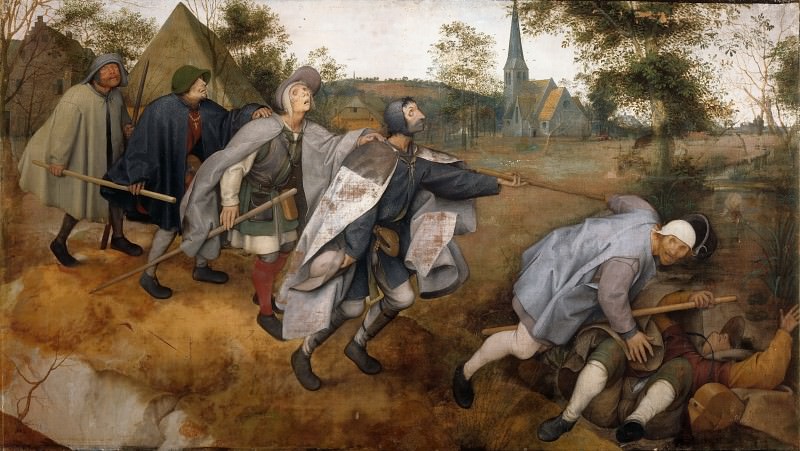The blinds Pieter Brueghel The Elder (1525-1569)
Pieter Brueghel The Elder – The blinds
Edit attribution
Download full size: 8200×4617 px (6,2 Mb)
Painter: Pieter Brueghel The Elder
Location: Museum Capodimonte, Naples (Museo di Capodimonte).
The painting was painted in 1568. Today it is in the Capodimonte Museum in Naples. Anyone who happened to read Charles de Koster’s wonderful novel, The Legend of Thyl Ulenspiegel, probably knows that during the Dutch Revolution, the entire nation took part in the violent struggle against the Spaniards for independence. One of the most important Dutch painters, draftsmen and engravers, who also took part in the birth of realist Flemish and Dutch art, Peter Bruegel the Elder, also took part in these events. He was an artist-thinker, constantly and intensely thinking about the meaning of life, Bruegel was far ahead of his time.
Description of Peter Brueghel’s painting The Parable of the Blind (The Blind Lead the Blind)
The painting was painted in 1568. Today it is in the Capodimonte Museum in Naples.
Anyone who happened to read Charles de Koster’s wonderful novel, The Legend of Thyl Ulenspiegel, probably knows that during the Dutch Revolution, the entire nation took part in the violent struggle against the Spaniards for independence.
One of the most important Dutch painters, draftsmen and engravers, who also took part in the birth of realist Flemish and Dutch art, Peter Bruegel the Elder, also took part in these events.
He was an artist-thinker, constantly and intensely thinking about the meaning of life, Bruegel was far ahead of his time. His vivid talent did not fit into the framework of generally accepted concepts and genres of art.
The main theme of Bruegel’s work is the depiction of the Dutch peasants and artisans of the city. He was one of the first painters to portray human labor. He had no desire to create an ideal image of people from the people, on the contrary, he tried to make their images as natural and direct as possible, deliberately rude.
There was always a certain amount of mischievous humor in the paintings of this artist. Characteristic in this respect are also grotesque figures of cripples and beggars, which the artist portrayed more than once. Bruegel’s biographers say that he purposely disguised himself in peasant attire in order to walk around the villages and get to know and study his depicted characters better.
Another characteristic of Bruegel’s artistic paintings is their character of parables. Usually, any of his paintings were not just a simple depiction of a group of people against a landscape, they were also an illustration of some well-known story. This is very evident in his last painting of the artist, The Blind (1568), in which he presented the famous parable of the blind man leading the other blind men.
This painting also has several other titles - The Parabola of the Blind, The Blind, The Blind Leading the Blind, The Blind Leading the Blind. For the subject the artist chose a biblical parable about the blind, which says that if a blind man leads a blind man, both will fall into a pit.
Кому понравилось
Пожалуйста, подождите
На эту операцию может потребоваться несколько секунд.
Информация появится в новом окне,
если открытие новых окон не запрещено в настройках вашего браузера.
You need to login
Для работы с коллекциями – пожалуйста, войдите в аккаунт (open in new window).




















COMMENTS: 1 Ответы
качество прекрасное – жалко картинки целиком нет-только кусочек для аппетита!
You cannot comment Why?
The subtexts of the painting are multifaceted and open to interpretation. Primarily, it is seen as a visual allegory for the human condition, with blindness symbolizing ignorance, sin, or the spiritual darkness that can afflict humanity. The falling men represent those who have strayed from the path of righteousness or who are succumbing to their weaknesses. The church in the background could signify a failed attempt to seek salvation or a reminder of divine judgment.
Furthermore, the painting can be interpreted as a commentary on the dangers of blind faith or following a misguided leader. The men are literally following each other, and the downfall of one seems to lead to the downfall of the next. This suggests a critique of societal or religious structures that lead people astray. The work might also be a reflection of the artists own struggles with faith or his observations of human folly and suffering in the 16th century. The stark realism and the grim depiction of the blind mens plight contribute to the paintings profound sense of pathos and its enduring power.